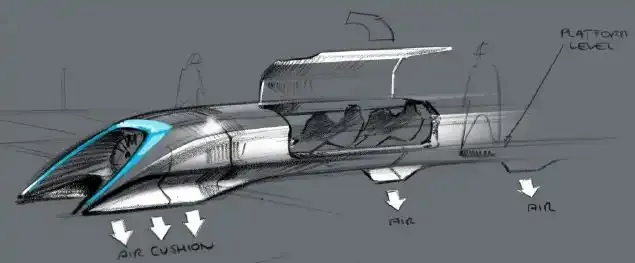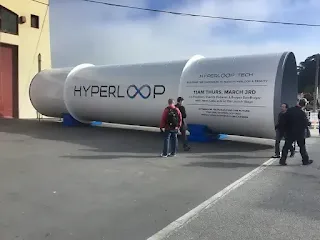Abstract
Hyperloop is one of the futuristic ideas re-initiated by the world-famous
billionaire – Elon Musk who is well known for
his multibagger companies – SpaceX, PayPal and X
(also known as Twitter) . As we all
known he is one of the inspirational figures of this world who always tries to
inspire our youth with his inventions and innovation and hyperloop was one of
the ideas he proposed. Thus, giving
birth (not really thou but metaphorically) to Hyperloop One, an American
transportation company. So, join me on this intellectual ride, where I am going to break
down complex concepts of hyperloop into digestible insights, making the
Hyperloop not just a transportation marvel but a glimpse into the future of
innovation. Thereupon get ready to ride the digital rails of knowledge!
Table Of Content
- Abstract
- What is Hyperloop ?
- How does an Hyperloop work ?
- What advantages the hyperloop would have over other types of transportation?
- What is the current status of hyperloop ?
- References
What is Hyperloop ?
Well, the concept of hyperloop was assumed to be introduced in 1904 but
as told in abstract, Hyperloop is concept restored by billionaire Elon Musk in
2013 who wants to cut transported time greatly. Thus, to achieve this goal he
created a company named Hyperloop One also known as Virgin Hyperloop or Virgin
Hyperloop One (don’t ask why he added the letter – ‘Virgin’). It is an open-source
initiative, the brainchild of Tesla and SpaceX, the Hyperloop emerged as a call
for global collaboration in advancing its technology. Hyperloop system is defined
for its high-speed travel, speed, comfort, and efficiency, envisioning the
future of rapid transportation. Beyond the imagination of airplanes, high-speed
rail (HSR), Maglev, classic rail, and
cars, the Hyperloop promises unmatched speed and efficiency to its passengers.
While initially visioned as a city-to-city transport, it's predicted to
redefine major city connectivity, standing as the fifth mode of transportation
alongside rail, road, water, and air. The Hyperloop journey is not just about its
speed; but it will be also a leap into the future of interconnected, swift, and
sustainable transportation.
How does an Hyperloop work ?
The Hyperloop is a cutting-edge transportation concept that combines
magnetic levitation, reduced air pressure, and linear induction motors to
enable high-speed travel in low-pressure tubes. The fundamental idea behind the
Hyperloop is to create a near-vacuum environment inside the tube, minimizing
air resistance and allowing for incredibly fast and efficient travel.
Firstly, the Hyperloop tube is designed to maintain a low-pressure
environment, similar to the conditions found at high altitudes. This
low-pressure setting significantly reduces air resistance, which is a key
factor in achieving high speeds. In fact, air resistance and friction are one
of the major factors of why we humans can’t achieve great speed on earth like
we do it in space. Magnetic levitation, or maglev, is an important component of
the Hyperloop's propulsion system. The passenger or cargo capsule is suspended
above the track using magnetic repulsion and attraction. This eliminates the
need for traditional wheels and significantly reduces friction, allowing for
smoother and faster travel.
Linear induction motors are strategically placed along the Hyperloop
tube. These motors generate electromagnetic fields that interact with magnets
on the capsule, propelling it forward. The linear induction system enables
precise control over the capsule's movement and allows for rapid acceleration
and deceleration. The Hyperloop capsule itself is designed with aerodynamics in
mind to further minimize air resistance. The specially designed streamlined
shape reduces drag, ensuring efficient movement through the low-pressure
environment of the tube. To maintain the low-pressure conditions within the
tube, vacuum pumps continuously remove air. This near-vacuum environment
enhances the overall efficiency of the system, enabling the Hyperloop to reach extreme
high speeds of about 1200 km/h to 1500 km/h (more than that of any airplane and that’s why I said
air resistance and friction really matter here).
Briefly, the Hyperloop's operation involves creating a low-pressure,
near-vacuum environment inside the tube, utilizing magnetic levitation for
suspension and propulsion, employing linear induction motors for precise
control and acceleration, and ensuring an aerodynamic capsule design to
minimize air resistance. This combination of technologies aims to revolutionize
transportation by offering a faster, more sustainable alternative for
long-distance travel.
What advantages the hyperloop would have over other types of transportation ?
Now, everybody including myself are having the question that ‘Why would we use hyperloop ?’ and ‘Just tell
me what is
that one advantage the hyperloop would have over other types of transportation?’ .Well, so let me
tell you that in comparison to our old railway systems, the Hyperloop presents
several advantages stemming from its innovative design and operational
principles. The challenges associated with modern railway transport, including
dynamic interactions between tracks and vehicles, become more pronounced with
higher transportation density, hauling mass, and operating speed. This
heightened dynamic interaction can result in issues related to ride comfort and
running safety. Well, we all want that ride comfort, right ?
In the context of evacuated tube transportation, the Hyperloop utilizes a Maglev train model, specifically designed for high-temperature superconducting (HTS) Maglev technology. Unlike commonly used high-speed trains, the influence of tracks on shock wave generation, particularly in terms of aerodynamic heating at the top surface, is notably diminished. However, it's really important to note that HTS Maglev trains can face aerodynamic thermal challenges within a closed tube, that affects the traffic safety, especially at high speeds . One notable advantage lies in the significant reduction of aerodynamic drag by lowering the air pressure within the Hyperloop system. This innovation addresses a key issue faced by High-Speed Rail (HSR), where wind tunnel tests on the aeroelastic model of the catenary system have been conducted to study wind vibration characteristics. These tests reveal that the displacement response of the contact wire under uniform flow is lower than under turbulent flow, enhancing overall stability (Yeah, stuffs for science lovers).
Not only that, but the Hyperloop minimizes the risk of galloping in overhead contact lines, a potential hazard for electric railways caused by aerodynamic instability. This innovation helps ensure the normal operation of the system, as large amplitude formations under wind load are eased. In short, the Hyperloop's advantages over other transportation modes are as follows :
- Reduced Dynamic Interaction Issues
- Diminished Aerodynamic Challenges
- Significant Aerodynamic Drag Reduction
- Enhanced Stability in Overhead Contact Lines
- Collectively contributing to a safer more efficient mode of high-speed transportation
What is the current status of hyperloop ?
As per the reports of TheMercury News and BBC
as of 21 December 2021, Hyperloop One which was a major company working on the concept
and realization of hyperloop has terminated all of its operations and backed
off completely. Hyperloop One
failed to secure a contract for constructing a functional hyperloop, attracting
attention for less-than-ideal reasons. One of its co-founder Brogan BamBrogan
encountered a distressing incident when he found a noose on his chair at work. Not
only this but, another co-founder, venture capitalist Shervin Pishevar, stepped
down following reports of sexual harassment allegations, which he denied.
Ziyavudin Magomedov, a former director, faced unrelated charges of fraud and
embezzlement in Moscow, with his arrest leading to an ongoing legal appeal.





